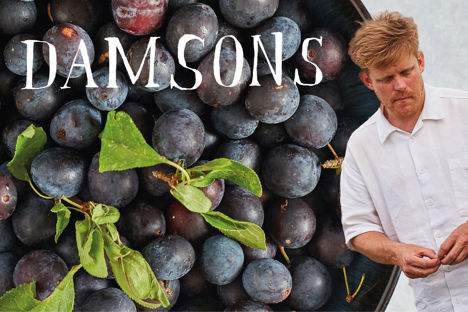
Sam Buckley: on damsons
At Sam Buckley’s Stockport restaurant Where The Light Gets In, September sees the team preserve dozens of damsons to use in the months ahead. In his new monthly column, Sam shares his love for this super-seasonal British fruit and how the Japanese technique he uses to preserve them represents a very different kind of food mile.
Sam Buckley: on damsons
At Sam Buckley’s Stockport restaurant Where The Light Gets In, September sees the team preserve dozens of damsons to use in the months ahead. In his new monthly column, Sam shares his love for this super-seasonal British fruit and how the Japanese technique he uses to preserve them represents a very different kind of food mile.
View more from this series:
Sam Buckley on...For me, the damson is the perfect foodstuff. It is hyper-seasonal and hyper-local; a quintessential taste of Britain throughout its fleeting season. However, like many ingredients now thought of as ‘native’ to the UK, this variety of plum has in fact traveled across many lands before reaching our shores, picking up resilience and leaving behind diversity and variety along the way. The damson (or Damask plum) is said to have originated in Damascus, Syria and probably found its way to us through the Romans via Italy and western Europe. Upon its arrival it is thought to have been grafted to the root stock of the blackthorn, the wild plant that is responsible for supplying us with sloes at the beginning of autumn.
Damons have been rooted in our soil for over 1,000 years and everybody knows at least one person with a tree in their back garden. They weave though our canon of literature, from Chaucer to Shakespeare, and are a firm favourite for jams sold in farm shops and country fairs the land over. You can’t find a damson in a supermarket – its urgency to ripen whilst still dangling from the branch makes it a worrisome traveller – but that’s what gives the fruit its nostalgic romance. If you want to enjoy a damson you’re probably going to have to pick one for yourself.
While it might seem that the best way to enjoy a damson is sat at the base of the tree from which it was plucked, if you can get a bucketful home without too much spoilage there is gain to be had in the preservation of these sour little plums.
In our kitchen we revere the damson for its fresh acidity and its ability to move through the menu from sweet to savoury. It is a perfect accompaniment to roast pork; works well with shellfish; makes a great country wine and of course there is little to compare with damsons baked into a flaky tart case served with a rich milk ice cream. But because of the speed with which they ripen we have to find ways to preserve them – which is where a technique from Japan comes in.
There is a sour plum that grows in the Far East that is actually a closer relation to the apricot than to the plum that we know. These fruits are preserved in salt and then dried; in Japan they are called umeboshi. I used to enjoy these for breakfast with a friend from Tokyo – her grandmother used to prepare and send them in a care package to England and we would enjoy these intensely sour morsels of joy on top of a bowl of steaming white rice. To get a similar hit from our damsons we harvest them slightly underripe and use the following preservation method so they can be enjoyed long after their short season.
‘Damson boshi’ has been in our pantry since we opened almost five years ago and in its own way it has been an emblem of our ability and willingness to travel to find new ideas. Since then the shelves around it have filled up, adding to our treasure room with preserves, pickles and ferments and strengthening our understanding of cultures and customs from all over the world.
Because the damson doesn’t travel well, it falls outside of the system that sees food flown round the world at the detriment of local economies, exasperating the rich-poor divide from east to west and negating seasonality and traditional nutritional values. Instead, this little plum stands central on our map as an example of a richer kind of food mile; one that joins people from different sides of the world, helping to highlight the virtues of local foods, preserving the systems they grow in and enriching the customs in which they can be enjoyed.
How to make Sam Buckley’s ‘damson boshi’ at home
Being careful not to tear or rupture the skins (which would result in the fermentation process being too rapid), we follow the steps used to create umeboshi by first weighing the damsons, then adding 8% of that amount in salt. We place this mixture into a jar with a weight over the top and allow a brine to naturally seep from the fruit. The fruit becomes submerged in this salty liquor which we later use to season meat broths. After about three weeks we drain the damsons and lay them out to dry in the sun. This process lasts for around three days, during which we turn them every couple of hours. Once we are happy with the level of moisture lost, we jar them up ready to use in a variety of ways throughout the year.


